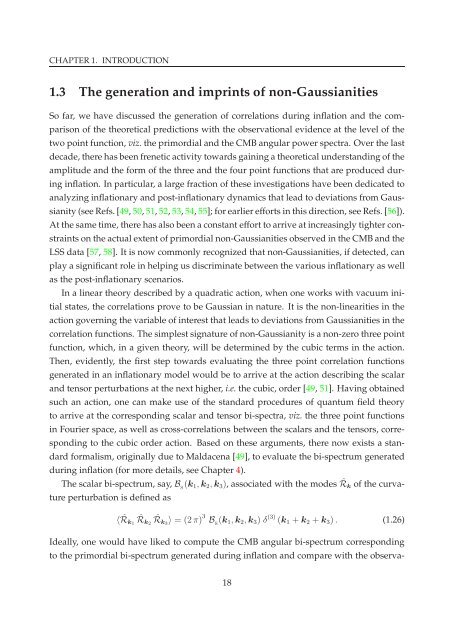PHYS08200605006 D.K. Hazra - Homi Bhabha National Institute
PHYS08200605006 D.K. Hazra - Homi Bhabha National Institute
PHYS08200605006 D.K. Hazra - Homi Bhabha National Institute
You also want an ePaper? Increase the reach of your titles
YUMPU automatically turns print PDFs into web optimized ePapers that Google loves.
CHAPTER 1. INTRODUCTION<br />
1.3 The generation and imprints of non-Gaussianities<br />
So far, we have discussed the generation of correlations during inflation and the comparison<br />
of the theoretical predictions with the observational evidence at the level of the<br />
two point function, viz. the primordial and the CMB angular power spectra. Over the last<br />
decade, there has been frenetic activity towards gaining a theoretical understanding of the<br />
amplitude and the form of the three and the four point functions that are produced during<br />
inflation. In particular, a large fraction of these investigations have been dedicated to<br />
analyzing inflationary and post-inflationary dynamics that lead to deviations from Gaussianity<br />
(see Refs. [49, 50, 51, 52, 53, 54, 55]; for earlier efforts in this direction, see Refs. [56]).<br />
At the same time, there has also been a constant effort to arrive at increasingly tighter constraints<br />
on the actual extent of primordial non-Gaussianities observed in the CMB and the<br />
LSS data [57, 58]. It is now commonly recognized that non-Gaussianities, if detected, can<br />
play a significant role in helping us discriminate between the various inflationary as well<br />
as the post-inflationary scenarios.<br />
In a linear theory described by a quadratic action, when one works with vacuum initial<br />
states, the correlations prove to be Gaussian in nature. It is the non-linearities in the<br />
action governing the variable of interest that leads to deviations from Gaussianities in the<br />
correlation functions. The simplest signature of non-Gaussianity is a non-zero three point<br />
function, which, in a given theory, will be determined by the cubic terms in the action.<br />
Then, evidently, the first step towards evaluating the three point correlation functions<br />
generated in an inflationary model would be to arrive at the action describing the scalar<br />
and tensor perturbations at the next higher, i.e. the cubic, order [49, 51]. Having obtained<br />
such an action, one can make use of the standard procedures of quantum field theory<br />
to arrive at the corresponding scalar and tensor bi-spectra, viz. the three point functions<br />
in Fourier space, as well as cross-correlations between the scalars and the tensors, corresponding<br />
to the cubic order action. Based on these arguments, there now exists a standard<br />
formalism, originally due to Maldacena [49], to evaluate the bi-spectrum generated<br />
during inflation (for more details, see Chapter 4).<br />
The scalar bi-spectrum, say, B S<br />
(k 1 ,k 2 ,k 3 ), associated with the modes ˆR k of the curvature<br />
perturbation is defined as<br />
〈 ˆR k1<br />
ˆRk2 ˆRk3 〉 = (2π) 3 B S<br />
(k 1 ,k 2 ,k 3 ) δ (3) (k 1 +k 2 +k 3 ). (1.26)<br />
Ideally, one would have liked to compute the CMB angular bi-spectrum corresponding<br />
to the primordial bi-spectrum generated during inflation and compare with the observa-<br />
18
















